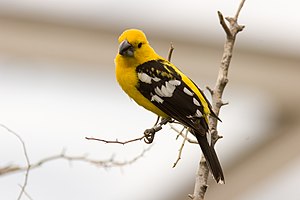Yellow-headed core crackers
| Yellow-headed core crackers | ||||||||||||
|---|---|---|---|---|---|---|---|---|---|---|---|---|

Yellow-headed Corecracker ( Pheucticus chrysopeplus ) |
||||||||||||
| Systematics | ||||||||||||
|
||||||||||||
| Scientific name | ||||||||||||
| Pheucticus chrysopeplus | ||||||||||||
| ( Vigors , 1832) |
The yellow-headed corncracker ( Pheucticus chrysopeplus ), sometimes also called gold-headed corncracker , is a species of songbird from the family of cardinals (Cardinalidae) that occurs in Central America .
description
Appearance
Adult yellow-headed core crackers reach a length of 21.5 to 24.0 centimeters. A female was measured to weigh 77.6 grams. There is a slight sexual dimorphism between the sexes . The head and neck of the males have a strong lemon yellow color. Sometimes some dark feathers appear in the area of the ear covers . The entire underside is also yellow. In the birds living in the southernmost regions, bright orange-yellow colors dominate. The yellow back plumage is marbled in dark brown. The wings and the control feathers are black, but the hand wings , arm wings and arm covers show wide white tips. The females show similar drawing elements as the males, but are drawn much paler and weaker overall. The head and cheeks are also more marbled in gray-brown. In both sexes, the conical beak is very large and powerful. The upper bill is blackish, the lower bill pale reddish to bluish in color. The feet are bluish gray in color. The iris is black-brown.
Vocalizations
The singing of the males of the yellow-headed core crackers consists of a series of strong and clear whistling tones that sound like "Tschi wi - Tschi wi" and are repeated more often. Sometimes a sharp, metallic sounding "pliehk" can be heard.
distribution and habitat
The distribution area of the yellow-headed core cracker includes areas in western Mexico and Guatemala . Individual specimens have been observed in southern Arizona during the summer months . The species prefers to live in tropical thorn and deciduous forests, sometimes also in moist, evergreen forest areas at altitudes of up to 2500 meters.
Subspecies
In addition to the nominate form Pheucticus chrysopeplus chrysopeplus , which occurs in western and central Mexico , two other subspecies are known:
- Pheucticus chrysopeplus dilutus van Rossem , 1934 - Northwest Mexico
- Pheucticus chrysopeplus aurantiacus Salvin & Godman , 1891 - Southern Mexico and Guatemala
Way of life
The birds feed primarily on fruits, berries and seeds, for example Ficus pertusa and Trichostigma octandrum . Little is known about the breeding behavior. The cup-shaped nest is made from withered grass, roots and leaves and padded with dry fibers from the beginning of June. It is laid out in dense bushes at low to medium heights and provided with two to five eggs. These have a bluish green color and are covered with small dark spots.
Hazard and protection
The yellow-headed core cracker is not uncommon in most of its areas of distribution and is therefore classified as ![]() " Least Concern " by the World Conservation Organization IUCN . Sometimes specimens are taken from nature to keep them as cage birds .
" Least Concern " by the World Conservation Organization IUCN . Sometimes specimens are taken from nature to keep them as cage birds .
swell
literature
- Josep del Hoyo , Andrew Elliott, David A. Christie: Handbook of the Birds of the World, Tanagers to New World Blackbirds. Volume 16, Lynx Edicions, 2011, ISBN 978-84-96553-78-1 .
Individual evidence
- ^ Brewer, D. (2016). Yellow Grosbeak (Pheucticus chrysopeplus). In: del Hoyo, J., Elliott, A., Sargatal, J., Christie, DA & de Juana, E. (eds.). Handbook of the Birds of the World Alive. Lynx Edicions, Barcelona. (retrieved from http://www.hbw.com/node/62180 on April 22, 2016).
- ↑ worldbirdnames ( Memento of the original from July 21, 2014 in the Internet Archive ) Info: The archive link was inserted automatically and has not yet been checked. Please check the original and archive link according to the instructions and then remove this notice.
- ^ IUCN Red List
Web links
- Yellow-headed Corecracker (Pheucticus chrysopeplus) in the Encyclopedia of Life . Retrieved August 11, 2017.
